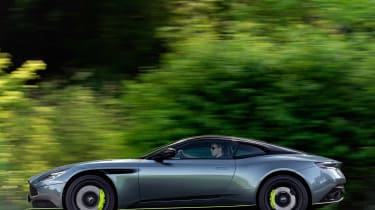Aston Martin DB11 (2017-2023) - MPG, CO2 and Running Costs
Turbocharged engines boost efficiency, but you’ll still need deep pockets to run the DB11
Aston has chosen to downsize its trademark V12 engine and introduce a V8 in an effort to boost efficiency. However, while the twin-turbocharged 5.2-litre V12 unit uses less fuel and emits less CO2 than the old naturally aspirated engine in the DB9, you’d struggle to call it frugal.
Despite the addition of stop/start technology, the DB11 V12 will return around 24mpg and emit 270g/km of CO2 on the combined cycle, or 24.8mpg and 265g/km for the DB11 AMR. And, given the car’s enormous performance potential, it's likely that hard use will soon see your fuel consumption dip into single figures. The V8 is a little better, with an official average of 28.5mpg, but again, if you use its power to the full, you won't get anywhere near that.
However, you don’t buy a V8- or V12-engined Aston Martin to save on your motoring bills, so this is unlikely to put off potential buyers. Even so, it’s worth keeping in mind the other costs likely to be incurred if you make the most of the Aston’s performance. Despite the car’s aluminium core, it still tips the scales at 1,770kg. As a result, hard use will result in heavy brake and tyre wear, particularly if you take your DB11 on track.
Insurance
British security and insurance experts Thatcham haven’t yet released grouping data for the DB11. However, given the car’s performance potential, relatively high value and hi-tech engineering it’s safe to say it won’t be a low rating.
That said, all models get a Thatcham category one alarm and immobiliser, but there’s also standard tracking device – you’ll have to pay an annual subscription fee to its service provider.
Depreciation
Our experts haven’t yet calculated residuals on the DB11, but its predecessor, the DB9, is currently hovering around 40 per cent of its new value after three years and 36,000 miles. We’d expect the DB11 to perform more strongly than this, certainly early on when demand for the car is strong and the available numbers are low.
This is certainly likely to be the case for the first cars, with second-hand prices likely to exceed new as eager customers try to avoid a lengthy waiting list for what is likely to be a sought after car.




